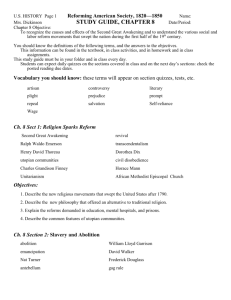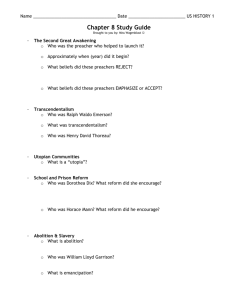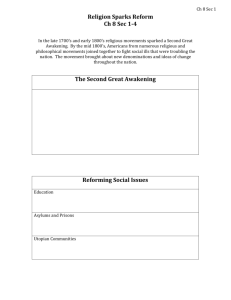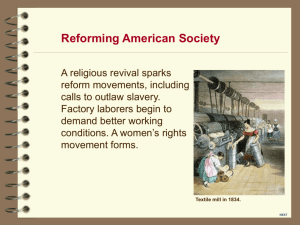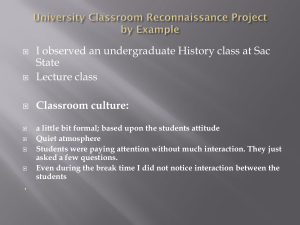assessment - Online Campus
advertisement
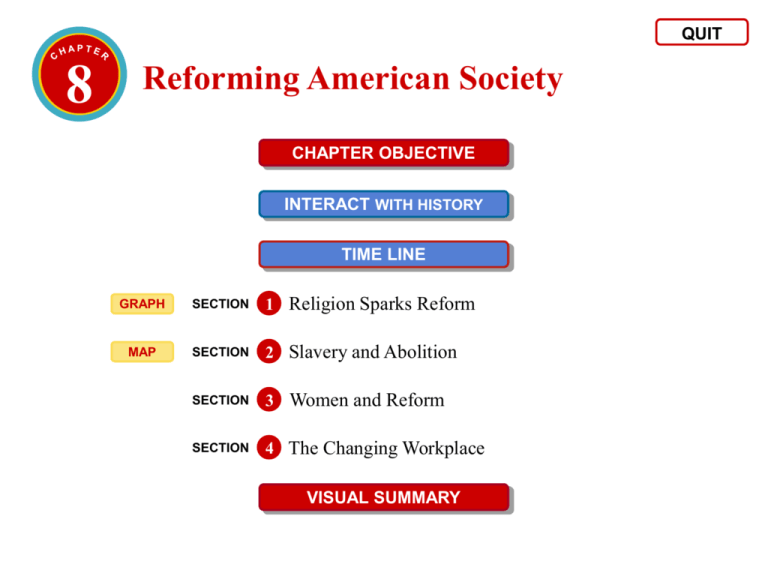
QUIT 8 Reforming American Society CHAPTER OBJECTIVE INTERACT WITH HISTORY TIME LINE GRAPH SECTION 1 Religion Sparks Reform MAP SECTION 2 Slavery and Abolition SECTION 3 Women and Reform SECTION 4 The Changing Workplace VISUAL SUMMARY HOME 8 Reforming American Society CHAPTER OBJECTIVE To recognize the causes and effects of the Second Great Awakening and to understand the various social and labor reform movements that swept the nation during the first half of the 19th century HOME 8 Reforming American Society INTERACT WITH HISTORY The year is 1834. You work in the textile mills in Massachusetts and provide most of the income for your family. The mill owners have gradually increased your workload to 12 hours a day. Now they are going to cut your pay by 15 percent. Coworkers are angry and are discussing what they can do. What would you do to improve working conditions? Examine the Issues • What are some conditions you would not tolerate? • What actions pressure businesses to change? • What moral arguments would you present? HOME 8 Reforming American Society TIME LINE The United States The World 1820 Revolts break out in Spain and Portugal. 1822 Large textile mill opens in Lowell, Massachusetts. 1827 Sojourner Truth is freed from slavery. 1829 David Walker prints Appeal, a pamphlet urging slaves to revolt. 1831 Nat Turner leads slave rebellion. 1832 Britain passes its first Reform Bill. 1833 Britain abolishes slavery in its empire. 1834 National Trades' Union is formed. continued . . . HOME 8 Reforming American Society TIME LINE The United States The World 1838 Frederick Douglass flees to New York City to escape slavery. 1839 French and British introduce first forms of photography. 1840 World's Anti-Slavery Convention is held in London. 1841 Utopian community is established at Brook Farm. 1845 Henry David Thoreau moves to Walden Pond. 1845 Great Potato Famine begins in Ireland. 1848 Seneca Falls Convention on women’s rights is held. 1848 Revolutions erupt across Europe, causing many Germans and others to move to America. HOME GRAPH 1 Religion Sparks Reform KEY IDEA A renewal of religious sentiment—known as the Second Great Awakening—inspired a host of reform movements. OVERVIEW ASSESSMENT HOME GRAPH 1 Religion Sparks Reform OVERVIEW MAIN IDEA WHY IT MATTERS NOW A renewal of religious sentiment—known as the Second Great Awakening—inspired a host of reform movements. Many modern social and political reform movements grew out of the reform movements of 19th-century America. TERMS & NAMES • Henry David Thoreau • revival • Charles Grandison Finney • civil disobedience • Dorothea Dix • Second Great Awakening • utopian community • transcendentalism • Ralph Waldo Emerson ASSESSMENT HOME GRAPH 1 Religion Sparks Reform ASSESSMENT 1. List four events and ideas that relate to the Second Great Awakening. Unitarian movement revivals Second Great Awakening Charles Finney transcendentalism continued . . . HOME GRAPH 1 Religion Sparks Reform ASSESSMENT 2. Consider the philosophical and religious ideas expressed during the Second Great Awakening and other religious reform movements. What were the key values and beliefs that guided 19th-century reformers’ actions? Think About: • concepts of individualism and individual salvation • attitudes toward social responsibility • the viewpoints of Finney, Channing, and Emerson ANSWER The reformers shared a strong belief in the power of the individual to improve him/herself and in individual responsibility for improving society. continued . . . GRAPH 1 HOME Religion Sparks Reform ASSESSMENT 3. How do you think the 19th-century reform movements in schools, prisons, and asylums might have influenced reform movements today? ANSWER Today’s reform movements are influenced by the ideals of equal rights, universal suffrage, an informed citizenry, and humane treatment of the incarcerated that grew out of 19th century reform movements. continued . . . GRAPH 1 HOME Religion Sparks Reform ASSESSMENT 4. Why might the idea of utopian communities appeal to the transcendentalists? ANSWER In utopian communities, transcendentalists would be able to practice their ideals of living a simple life and being close to nature. End of Section 1 HOME MAP 2 Slavery and Abolition KEY IDEA Slavery became an explosive issue, as more Americans joined reformers working to put an end to it. OVERVIEW ASSESSMENT HOME MAP 2 Slavery and Abolition OVERVIEW MAIN IDEA WHY IT MATTERS NOW Slavery became an explosive issue, as more Americans joined reformers working to put an end to it. The people of the United States continue to be challenged by questions of economic and social inequality. TERMS & NAMES • emancipation • gag rule • William Lloyd Garrison • David Walker • antebellum • Frederick Douglass • Nat Turner • abolition ASSESSMENT HOME MAP 2 Slavery and Abolition ASSESSMENT 1. Look at the chart to help organize your thoughts. List the major antislavery and proslavery actions that occurred from 1820 to 1850. Antislavery Actions Proslavery Actions Publication of The Liberator and Appeal to the Colored Citizens of the World; formation of antislavery societies; Nat Turner’s rebellion The defeat of the Virginia motion for abolition; tighter slave regulations; the growth of vigilance committees; and the 1836 gag rule continued . . . MAP 2 HOME Slavery and Abolition ASSESSMENT 2. Which do you think was a more effective strategy for achieving the abolitionists’ goal of eliminating slavery— violence or nonviolence? Why? Think About: • Garrison’s and Walker’s remarks • Frederick Douglass’s views • Southerners’ reactions to Nat Turner’s rebellion ANSWER Antislavery violence was more effective because it forced the nation to pay more attention to slavery, but it tended to elicit equally strong and violent reactions from slaveholders. continued . . . MAP 2 HOME Slavery and Abolition ASSESSMENT 3. What arguments did Southern proslavery whites employ to defend slavery? ANSWER They used the Bible to defend slavery, invented the myth of the happy slave as part of the plantation family, and argued that free blacks in the North were not as well-off as Southern slaves. continued . . . MAP 2 HOME Slavery and Abolition ASSESSMENT 4. Compare the similarities and differences between the situations of free blacks in the North and slaves in the South. ANSWER North: forced into the lowest-paid, least desirable jobs South: might labor in cotton fields or work in owners’ homes; some had skilled jobs in factories, but wages went to owners. End of Section 2 HOME 3 Women and Reform KEY IDEA Women reformers expanded their efforts from movements such as abolition and temperance to include women’s rights. OVERVIEW ASSESSMENT HOME 3 Women and Reform OVERVIEW MAIN IDEA WHY IT MATTERS NOW Women reformers expanded their efforts from movements such as abolition and temperance to include women’s rights. The efforts of 19th-century women reformers inspired both woman suffragists in the early-1900s and present-day feminist movements. TERMS & NAMES • cult of domesticity • Lucretia Mott • Seneca Falls Convention • Elizabeth Cady Stanton • Sarah Grimké • temperance movement • Sojourner Truth • Angelina Grimké ASSESSMENT HOME 3 Women and Reform ASSESSMENT 1. Look at the graphic to help organize your thoughts. List historical events, ideas, or people that relate to the idea of women addressing inequality. Women address inequality The cult of domesticity Elizabeth Cady Stanton The Grimké sisters Sojourner Truth continued . . . 3 HOME Women and Reform ASSESSMENT 2. The Seneca Falls “Declaration of Sentiments” asserted that “Woman is man’s equal.” In what ways would that change the status women held at that time? Cite facts to support your answer. Think About: • women’s social, economic, and legal status in the mid-1800s • married women’s domestic roles • single women’s career opportunities and wages ANSWER Equal status with men would change women’s subservient role. It would give them rights to property, to vote, to act as legal guardians for their own children, and to earn equal wages for the same jobs. continued . . . 3 HOME Women and Reform ASSESSMENT 3. In what ways did the reform movements affect the lives of women—both white and African American? ANSWER Women were deeply involved in the issues of abolition and temperance and less heavily involved in issues of women’s rights. continued . . . 3 HOME Women and Reform ASSESSMENT 4. Why do you think that many of the people who fought for abolition also fought for women’s rights? ANSWER Opposition to abolition made many women abolitionists determined to join other reform movements, such as women’s rights and the temperance movement. End of Section 3 HOME 4 The Changing Workplace KEY IDEA A growing industrial work force faced problems arising from manufacturing under the factory system. OVERVIEW ASSESSMENT HOME 4 The Changing Workplace OVERVIEW MAIN IDEA WHY IT MATTERS NOW A growing industrial work force faced problems arising from manufacturing under the factory system. The National Trades’ Union was the forerunner of America’s labor unions today. TERMS & NAMES • journeyman • master • National Trades’ Union • apprentice • strike • cottage industry ASSESSMENT HOME 4 The Changing Workplace ASSESSMENT 1. Name things that contributed to the changing workplace in the first half of the 19th century. power looms production lines manufacturing techniques in textile industry The Changing Workplace use of unskilled workers mechanization multi-factory sites continued . . . 4 HOME The Changing Workplace ASSESSMENT 2. Do you think the positive effects of mechanizing the manufacturing process outweighed the negative effects? Why or why not? Think About: • changes in job opportunities for artisans, women, and unskilled male laborers • changes in employer-employee relationships • working conditions in factories • the cost of manufactured goods ANSWER Positive effects include the reduced cost and wider availability of manufactured items, and expanding opportunities for women and unskilled male workers. Negatives include poor working conditions, loss of family businesses, pollution and the breaking up of families and communities as people left home to work in factories. HOME 4 The Changing Workplace ASSESSMENT 3. If you were working in a factory during the mid-1800s, would you be a striker or a strikebreaker? ANSWER Native-born Americans working in skilled trades were most likely to support strikes. Strike-breakers might have been unskilled laborers desperate for any kind of work. continued . . . 4 HOME The Changing Workplace ASSESSMENT 4. How did the influx of new immigrants from Germany and Ireland affect circumstances in the American workplace? ANSWER Immigrants had an impact in Northern cities. Irish immigrants, for example, were a threat to existing skilled labor and were seen as unfair competition. End of Section 4
